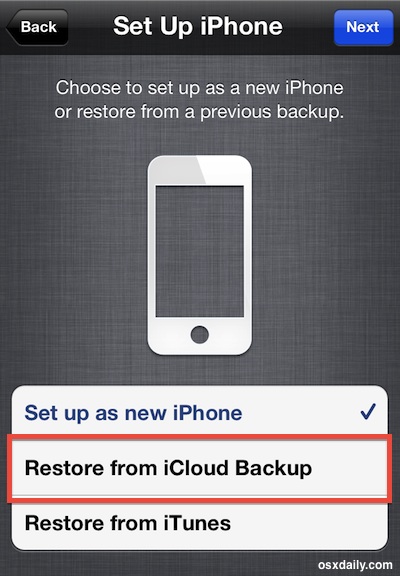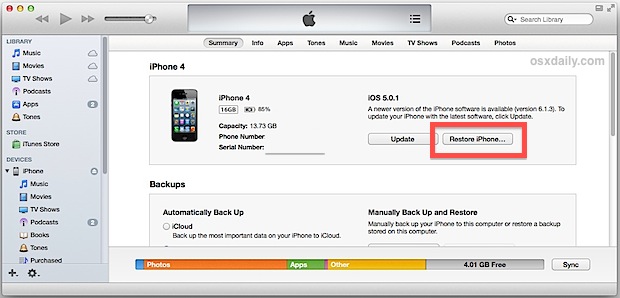 Restoring an iPhone to a previous backup is really easy, and though it’s fairly rare that you will need to restore an iPhone, or any other iOS device for that matter, it can still be necessary from time to time. What restoring from a backup does is pretty straight forward: it clears everything off the device, installs a clean version of the iOS system software, then recovers all personal stuff to exactly what it was like from the last backup. This is one of many reasons why making regular backups is recommended, particularly if you’re participating in any major iOS upgrades, adjustments, or tweaks (jailbreak or otherwise), because it lets you return to the last guaranteed functioning state of the device, with all of your data, apps, and customizations intact.
Restoring an iPhone to a previous backup is really easy, and though it’s fairly rare that you will need to restore an iPhone, or any other iOS device for that matter, it can still be necessary from time to time. What restoring from a backup does is pretty straight forward: it clears everything off the device, installs a clean version of the iOS system software, then recovers all personal stuff to exactly what it was like from the last backup. This is one of many reasons why making regular backups is recommended, particularly if you’re participating in any major iOS upgrades, adjustments, or tweaks (jailbreak or otherwise), because it lets you return to the last guaranteed functioning state of the device, with all of your data, apps, and customizations intact.Iif you’re new to the process of backups and restoration, don’t let the technical sounding nature make you shy away from the process. It’s actually quite easy with the iPhone, and we’ll show you exactly how to do it either from iTunes, if the phone was synced and backed up to a computer, and also how to do it with iCloud, if the phone is backed up to Apple’s remote servers. The iCloud method is by far the easiest, most applicable to new iPhone users, and it’s also pretty quick, so we’ll cover that first, but feel free to jump below to the iTunes method if that’s what you would rather do.
Restore an iPhone from an iCloud Backup
iCloud backups are generally the easiest to restore from because the entire process can be done remotely and on the iPhone itself, it does not require a connection to a computer, and iTunes is not necessary. The only two requirements for restoring from iCloud backups are having an iCloud account that is active, and having a recent iCloud backup to return back to. Going the iCloud route is actually two distinct steps: clearing the phone, then restoring from backup, here is how to do both:
- Open Settings, go to “General”, then go to “Reset”
- Choose “Erase All Content and Settings” and confirm the reset by tapping “Erase iPhone” – let this process complete, it will take a minute or two and the iPhone will reboot
- When the iPhone has booted, walk through the setup screen, and when you get to “Set Up iPhone”, ignore the other options and choose “Restore from iCloud Backup”

Let the iCloud restoration begin and finish itself, this may take a while depending on how much stuff you had backed up and how fast the internet connection is. Don’t interrupt the phone during this process and don’t let it run out of batteries either, otherwise you can end up with a ‘bricked’ device that requires a manual hard restore through recovery mode, which is a much more complex process.
How to Restore iPhone from a Backup with iTunes
This method requires the iPhone has been backed up recently to iTunes through a computer. Typically this is done anytime an iPhone has been connected to a computer through a USB cable, assuming auto-sync has been enabled. The instructions are identical for Mac OS X and Windows users, since iTunes is basically the same on both platforms:
- Connect your iPhone to the computer and launch iTunes
- Right-Click on the iPhone and select “Restore from Backup” – OR – choose the “Summary” tab in iTunes, then click the “Restore” button
- Choose the appropriate backup (typically the most recent listed by the “Last Synced” time) with the name of the iPhone to restore to
- Click ‘Restore’ to start the process to recover from that backup
The “Restore iPhone” button is highlighted in this screenshot:

The appearance is slightly different from various versions of iTunes, but the process is always the same. As mentioned, the right-click menu also let’s you restore from backups and looks like this:

If you find that the last synced time is not particularly recent, you just need to backup your iPhone more often! Keeping frequent backups is a good idea across all devices, whether its your Mac, PC, iPhone, iPad, or whatever.
Restores All Backed Up Data: Contacts, Calendars, Notes, etc
Be aware that both the iCloud or iTunes process restores just about everything, including the contacts, calendars, notes, iMessages and text messages, phone calls and call history, apps, app settings, and general system settings, but it does not revert to prior versions of iPhone firmware or baseband, which is generally impossible these days, nor does it wipe the iPhone and restore to all factory settings, which is a different process in that the phone is basically reset and then appears as if it was first turned on out of the box (in other words, there is no usage of the backup). If you’re accustomed to the world of iOS modifications and jailbreaking, you’ll find the process tounjailbreak an iPhone or iPad is quite similar.
Restoring from a backup can be a meaningful troubleshooting trick if you’re experiencing many unexplained problems with the iPhone. If things are just running weirdly, battery drains exceptionally quickly, apps are crashing or just aren’t working properly, and when there is quite clearly a problem with the iOS system software or some specific settings on the device. In most cases, a complete restoration will resolve such a problem, but if it doesn’t then you may need to take further actions through the official AppleCare line or Genius Bar.
Very useful ! check this link too you can find posts you might be interested how to factory reset iphone 4
ReplyDeleteEverything has its value. Thanks for sharing this informative information with us. GOOD works! Veeam Thailand
ReplyDelete